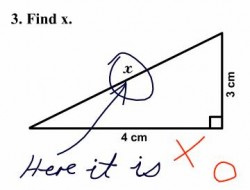How you can be good at math, and other surprising facts about learning | Jo Boaler | TEDxStanford
Incorporating technology into math classrooms allows for collaborative learning experiences that support problem solving and flexible thinking. By integrating content-specific and content-neutral technology, teachers and students can construct their learning together in ways that enhance math education.
Both content-specific and content-neutral technology can be effective in the math classroom when used appropriately. Content-specific apps and websites that use virtual manipulatives have been found to be highly effective in supporting conceptual understanding. Content-neutral technology, such as virtual whiteboards and student collaboration apps, can promote deep mathematical thinking when used in ways that encourage reflection, sharing, and connecting ideas.
However, most articles I read explain that it is important for teachers to be critical consumers of technology. The educational technology market is full of new apps and tools, but teachers should ensure that the technology they introduce aligns with research-based best practices for math instruction and supports healthy and productive mathematics learning.
Technology integration in math classrooms should be purposeful and aligned with pedagogical content knowledge. By using technology in ways that promote active learning and deep mathematical thinking, educators can enhance the mathematics learning experience for students.
One study investigated the impact of tablet-based cross-curricular maths activities on higher-order learning outcomes in third grade classrooms in Slovenia. The experimental group used tablets for math activities, while the control group used traditional pencil and paper methods. The results showed that the tablet group had better outcomes in conceptual knowledge, procedural knowledge, and problem-solving abilities. Afterwards the authors argued for the introduction of tablets in schools, as they provide interactive manipulatives and support learning across different domains. Overall, tablets were found to be effective in promoting higher-order achievements in maths.(Volk et al., 2017) Third grade students at a Midwestern elementary school participated in a 9-week mobile learning intervention (MLI) study. Two classrooms used Everyday Math and traditional methods for learning multiplication, while the other two classrooms used Everyday Math and web applications on iPod touches for daily practice. The MLI students performed better on a postintervention multiplication test compared to the comparison students. The advantage of the MLI students was statistically significant, with a medium-sized effect. (Examining the Influence of a Mobile Learning Intervention on Third Grade Math Achievement, n.d.)
The Education Program for Gifted Youth (EPGY) at Stanford University has developed online Math and Language Arts courses for underachieving students of low socioeconomic status. The courses aim to improve their learning in these subjects. The study analyzed the performance of students on state tests over a four-year period. The results showed that sustained computer-based work, guided by motivated teachers, can be effective for students at their current level of competence. The more computer-based course work students completed, the greater the gains they made. Additionally, students with lower pre-test scores benefited more from the technological support.(Suppes et al., 2014) The analysis supports the conclusion that online computer-based courses can effectively improve math and language arts learning for underachieving students of low socioeconomic status. The study also found that more industrious students had significantly higher score gains. The results highlight the potential of educational technology to improve elementary and middle school education, particularly for underachieving students. However, the article emphasizes that technology alone is not the solution and that teacher support is crucial in managing classrooms and motivating students.(Suppes et al., 2014)
Overall technology is a great tool in a math class if the teacher has time and the resources to properly plan, test, and implement it. Math Therapy with Vanessa Vakharia/Peter Liljedahl Teaching students to… think?
References
Examining the Influence of a Mobile Learning Intervention on Third Grade Math Achievement. (n.d.). Retrieved December 6, 2023, from https://www.tandfonline.com/doi/epdf/10.1080/15391523.2012.10782597?needAccess=true
Suppes, P., Liang, T., Macken, E. E., & Flickinger, D. P. (2014). Positive technological and negative pre-test-score effects in a four-year assessment of low socioeconomic status K-8 student learning in computer-based Math and Language Arts courses. Computers & Education, 71, 23–32. https://doi.org/10.1016/j.compedu.2013.09.008
Volk, M., Cotič, M., Zajc, M., & Istenic Starcic, A. (2017). Tablet-based cross-curricular maths vs. Traditional maths classroom practice for higher-order learning outcomes. Computers & Education, 114, 1–23. https://doi.org/10.1016/j.compedu.2017.06.004
Math Therapy with Vanessa Vakharia/Peter Liljedahl Teaching students to… think?




Leave a Reply